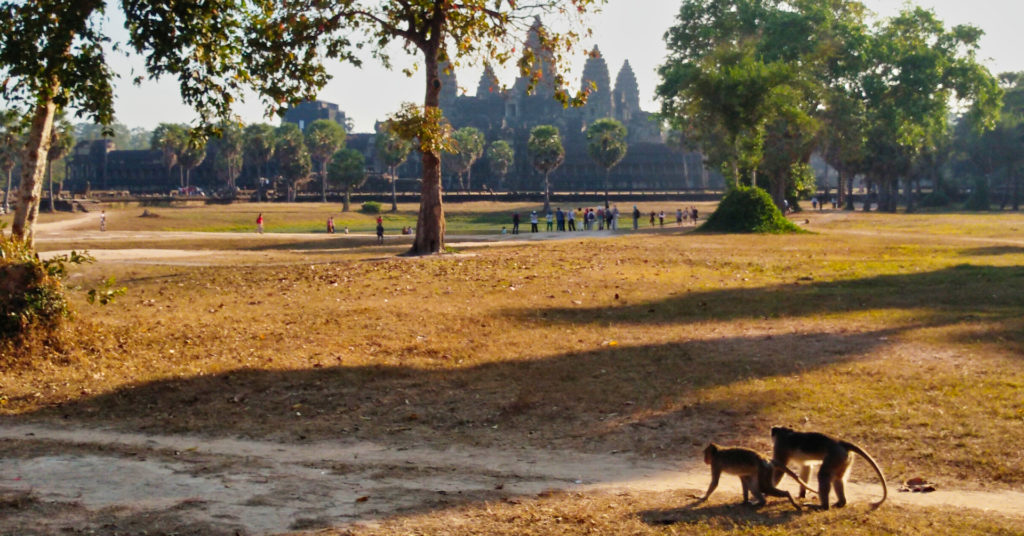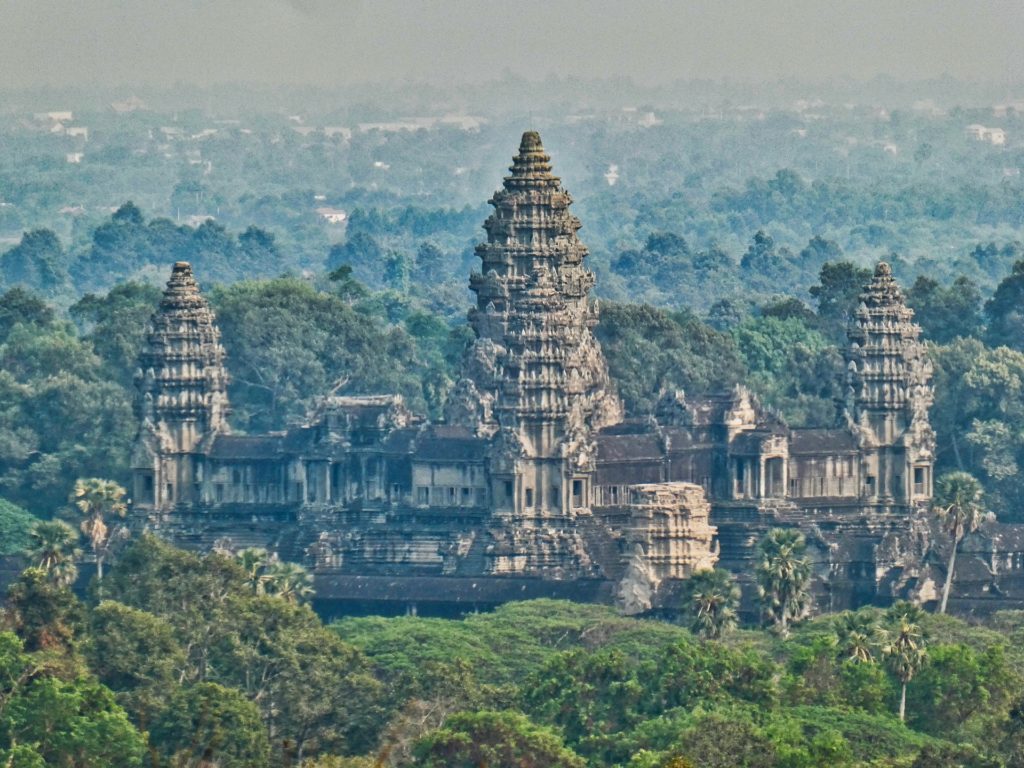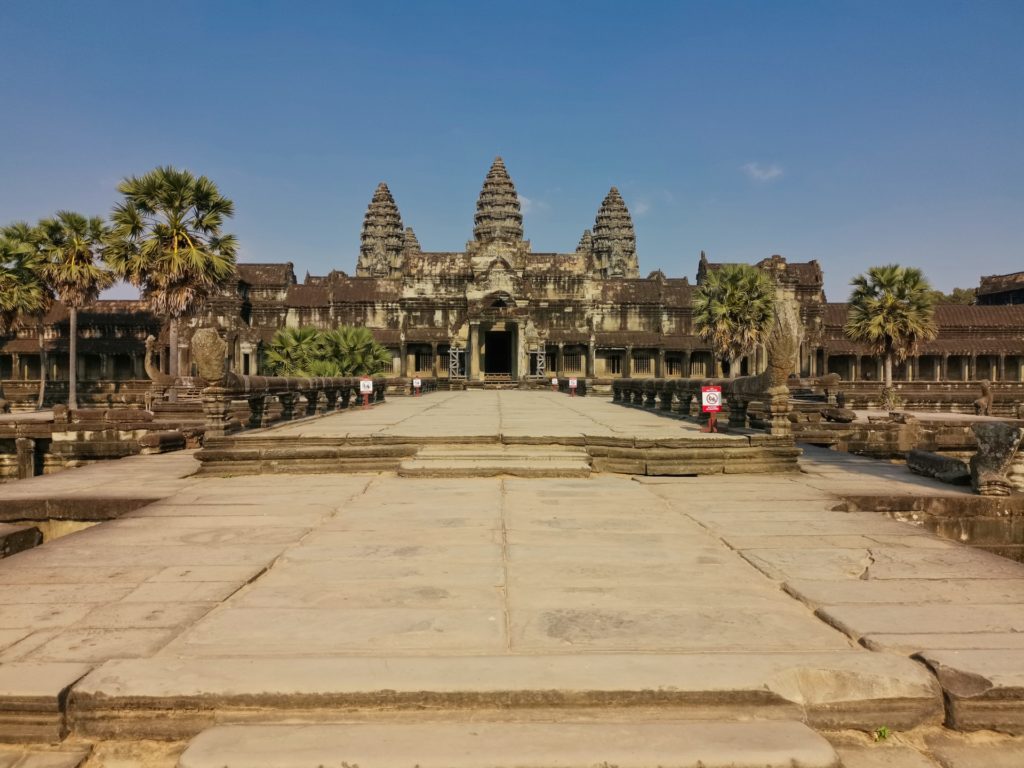Angkor Wat – The Heart of cambodia
The largest temple in the world – Angkor Wat
Angkor Wat is not only the most important temple complex in Cambodia, it is also the most famous among Western tourists and a very popular destination. Located only about 20 kilometers away from the Tonle Sap lake in the Angkor region not far from Siem Reap, the site is one of the fixed points on any major temple tour. It stands as an example of the incredibly detailed and advanced Khmer architecture and is not only the country’s biggest sight, but also decisively shapes the image of Cambodia. Even the Cambodian flag has featured the magnificent complex since 1948 (interrupted by Khmer Rouge rule and civil war): a distinctive feature, as only Afghanistan besides Cambodia has a historic structure depicted on its national flag.

Exterior view of the temple complex of Angkor Wat
The most important temple of the park – Angkor Wat
Surrounded by a moat and accessible by a bridge, the temple is one of the most impressive historical relics in the world. The 1000-year-old walls and ruins are adorned with Buddhist shrines, which are still visited by monks and believers.
From the 9th to the 15th century, the Angkor region was the political and cultural center of the Khmer Empire. The rulers, who gained much wealth through a complex system of rice cultivation and export all over the world, flaunted their power by building several large capitals in the region.

Monkeys in the archaeological park of Angkor Wat
The center of these cities was always a large temple, around which other smaller sanctuaries were built. The largest of these temple complexes is Angkor Wat. In 37 years, the temple complex was built under King Suryamvarman II, who ascended to the throne in 1113
Angkor Wat means something like “city of temples”. However, the real name of the temple is not known, it is believed that it was named after its deity “Vrah Vishnuloka” (“sacred abode of Vishnu”). This took place at a time when the Khmer had not yet turned to Buddhism. It was not until the religious revolution in the 13th century that the temple was renamed Angkor Wat. A little later it was rededicated as a Buddhist “Wat”, i.e. a traditional monastery.
This was made possible by some strategically well executed and very profitable war campaigns of the king, who thus had the resources not only to restore old temples, but also to commission new buildings. This not only strengthened his reputation among his own population, it was also a demonstration of power to other peoples, who were sometimes very impressed by the magnificent buildings, so that this is also recorded in many travel reports (for example, Chinese visitors).
Angkor Wat served as a state temple for King Suryavarman II and was located in the capital Yasodharapura, which had been built under Suryavarman I. The building was also used as a temple for the people. From the composition of the structure, it can be assumed that the building was never completed: With the demise of King Suryavarman II, work on Angkor Wat probably also ceased. When finally in the 13th century under Jayavarman VII the state religion was changed from Hinduism to Buddhism and numerous temple complexes of the Khmer Empire were supplemented by Buddhist elements, it was also the case in Angkor Wat that it was used more and more as a Buddhist place of worship – probably also because the temple was never completely left behind and thus it was included in the changes that the new times brought. Even today, the picture of daily visitors to the temple includes tourists as well as many Buddhist monks who pay a visit to the temple.

View of Angkor Wat from Phnom Bakheng
The influence of the West in colonial times started in Angkor Wat earlier than in the other temple complexes of the former Khmer Empire: already in the 19th century, the first travel reports of exploratory trips appeared, which attracted more and more adventurers to the site, who wanted to explore the history of the temple there (interestingly, also under the assumption that the complex would exist since ancient times, which was later disproved). In the 20th century, under the direction of a team of French researchers, the entire site was uncovered again and the reliefs and inscriptions were systematically documented and analyzed, which to this day is the basis for all the knowledge we have about the temple. Art theft and vandalism also occurred at Angkor Wat over the centuries, but especially during the time of the European voyages of discovery. The structure itself, however, remained reasonably undamaged: it is mainly the ravages of time that have left their mark on it, such as weathering and the intrusion and explosive power of flora and fauna. Since 1992, Angkor Wat has had the status of a UNESCO World Heritage Site.
The story of the construction of Angkor Wat in itself is extraordinarily fascinating: for example, the construction is said to have taken about 37 years (it is said that 300,000 people and 6,000 elephants were needed to accomplish this work). What is special is that the temple is not oriented to the east as usual, but to the west to the god of the dead, Yama (which was normally only common for cemeteries and mausoleums, but not for temples)
Angkor Wat has a size of about 200 hectares and is surrounded by a large moat, which may also have protected the structure somewhat from the “ingrowth” of nature over the centuries. The buildings were constructed of sandstone, as is common in the region. There are four corner towers and a large central tower (a reference to Mount Meru, the world mountain that is at the center of the universe of Hindu, Buddhist and Jain mythology): In spring and in autumn at the equinox, the sun is exactly above the central tower.
There are numerous reliefs and inscriptions on the walls, but the thousands of figures and statuettes are particularly impressive.

View of the Terrace of Honor and Angkor Wat over the Rainbow Bridge (main entrance)
The complex therefore exemplifies the architectural style of the Khmer culture: Angkor Wat itself, which has an exact symmetry, is supposed to represent the world. The highest of the five towers stands for Mount Meru, which in Khmer tradition represents the center of the world. The moat surrounding Angkor Wat is said to symbolize the primeval ocean. Each structure of the temple was planned and divided in the ground plan on four squares. This represents absolute perfection in Hinduism, which is represented by the number four.
The sandstones were brought by rafts through the numerous channels of the complex.
Every year, Angkor Wat is visited by 2 million tourists, mostly from China and the United States: For this reason, visitors should be prepared for the temple to be somewhat crowded most of the time, with waiting times at popular photo spots. Nevertheless, it can be said that the unique beauty and historical significance of the temple makes it worthwhile to pay a visit to the site anyway. Tourism has now become a valuable economic factor and source of income for the residents of the surrounding areas.
In Hinduism, Vishnu is believed to rule the western quadrant of the earth. However, the temple has another function. It is designed as a final resting place for its builder, the Khmer king Suryamvarman II
Therefore, it must be oriented towards the realm of the dead, which according to Hinduism lies in the west. The inscriptions of the temple represent a valuable source for the study of Khmer culture. They are decorated with representations of numerous Hindu mythologies and Khmer ideas. Strikingly, many of the temple walls depict apsaras, half-human, half-divine dancers who are comparable to nymphs as spirits of the clouds and waters. Divinity, to which the Khmer attributed their power, is also a popular motif of the countless temple decorations.
Exciting world of ruins – Angkor Thom
Angkor Thom is actually not a temple at all, but the legendary capital of the temple complex. On the back of a traditionally purple decorated elephant, you are carried through the city gate to the ruins of the ancient state temple. In the old, but well preserved stone monuments you can still recognize the faces of past Buddhist deities. The over 1000 year old walls, in which these faces were carved with the highest precision and artistry, continue to arouse fascination in millions of tourists each year. The Elephant Terraces are also worth a visit. As the name suggests, dozens of elephants are depicted here in stone on the outer wall of the temple complex.
The Angkor Thom temple is best visited early in the morning, because from noon Chinese tourists come in large masses with buses and so an experience of the mystical atmosphere of the place is no longer so good.
The “Tom Raider” Temple – Ta Prohm
Another highlight of the park is certainly the jungle temple Ta Prohm. The ruins gained great fame through Hollywood classics such as Tomb Raider and Indiana Jones. The numerous temples are regularly restored and maintained. At Ta Prohm, however, care is taken not to damage the vegetation either. Therefore, the entire site is riddled with wild vegetation and many tree roots. Many structures have completely or partially collapsed and nature is slowly but surely reclaiming its territory. A special sight is the huge strangler fig that entwines the masonry.
The most impressive sight in Asia
An Angkor Wat trip should be well planned and structured. The entire complex is over a hundred square kilometers in size and can by no means be completely discovered on foot. The fascination that this site leaves behind is worth the trip.